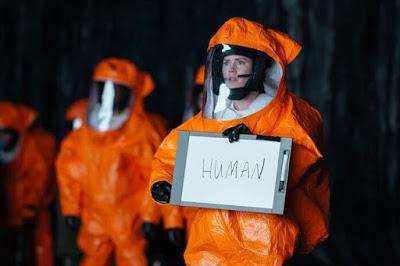Format: DVD from NetFlix on rockin’ flatscreen.

Since one of my degrees is in linguistics, I’ve been asked about Arrival pretty much since it came out. In fact, one of my professors was interviewed about just how closely the film would track attempting to learn an entirely alien language. It’s worth reading that interview, partly because it offers clearer insight on the science than I could offer and because Dr. Birner is awesome. Either go check it out now and come back, or go there as soon as you’re done here. Really.
Anyway, linguistics is front and center in Arrival. More specifically, as you’ve read or will read, Arrival is a big fan of the Sapir-Whorf hypothesis, specifically the idea of linguistic determinism. Allow me to get mildly professorial here for just a moment. The lighter, more acceptable (and much more potentially provable) version of the Sapir-Whorf hypothesis suggests that the language that we speak affect the way that we communicate—that how we communicate with others is relative to the language that we speak. It makes a certain sense; it’s a hypothesis (linguistic relativity) that I think is at least partially true. The stronger version, and one that Arrival very much wants to put forth, is that our language determines how we see the world, which goes too far for what Sapir-Whorf can support.
In many ways, Arrival is a great deal of linguistic joy with some really good special effects. I mean that only positively since I am a linguistics nerd. When the movie starts, linguistics professor Louise Banks (Amy Adams) discovers that no one in her class is paying attention. The reason is soon clear: twelve gigantic alien spacecraft have appeared at different spots around the globe. Louise is contacted by Col. G.T. Weber (Forest Whitaker) to go attempt to decode the alien language, and even to see if the aliens have language. Accompanying them is physicist Ian Donnelly (Jeremy Renner).
What they learn is that the aliens can evidently control gravity, and that the ship opens up for a couple of hours every 18 hours, allowing people to go in and attempt to communication. Ian is immediately a part of the incoming group, but it’s Louise who becomes to focus of this as the language expert. When they go in, a pair of aliens appear behind a glass wall. It’s evident that they are talking (a bit like whale sound), which makes communication difficult. Louise starts attempting to communicate with them to no avail. This changes when she brings a small whiteboard with her and starts attempting to communicate through written language.
This then sparks a new phase in learning to speak with the seven-legged aliens. Once the whiteboard appears, the aliens begin creating strange pictograph-like images made from an inky smoke-like substance from their limbs. Louise starts attempting to build a vocabulary between her and the aliens through the whiteboard, analyzing the creatures’ written language to develop a way to communicate with them in their own language. Eventually, she has built up enough common words that she is able to ask them why they have come to Earth.
Through all of this, we hear about the chaos that is happening around the planet because of the arrival of the creatures. Even more, we learn that the other 11 spacecraft, which have all landed in different countries, are undergoing different experiences with the aliens and communicating with them in different ways. In particular, the ship that has appeared in China is problematic, since the Chinese have apparently decided to communicate through mahjongg. Eventually, the Chinese stop sharing information, and other countries follow suit, blacking out any information that comes from around the world, leaving Louise more or less on her own.
There’s a lot more going on here, but Arrival is not a movie to have spoiled for you. If you haven’t seen this, there are things there that take up a great deal of the narrative that I’d rather not even mention at all. The biggest part of this is the ultimate question that Louise asks at the end of the film, and it's a question you need to see for yourself rather than having me spoil it for you.
There are some things that make me really happy, though. How Louise goes about deciphering the alien language makes sense. It’s good linguistics, and exactly mirrors the way that two people who have no common language develop a way to speak to each other. That’s smart. It happens far too quickly, but it’s the right process, and Louise’s methods are absolutely correct.
At this point, I haven’t seen any of the Best Actress nominations for the current year, but this was either the greatest year in the last several decades for actress performances or Amy Adams was robbed completely of a nomination. Forest Whitaker is also very good in this, and I could potentially see a supporting nomination for him, although “robbed” is too strong a word. The same could be said for Jeremy Renner, who is probably the male lead, but is also really in a supporting role.
Is there a problem here? There is, and it’s in the science. Linguistic determinism is a hypothesis that I don’t think a single modern linguist would accept. If there are any, they are in a severe minority. In fact, I’ve met linguists who don’t buy the very easily-accepted idea of linguistic relativity, one that is easily demonstrable by things like the way various languages classify colors and shapes. It goes too far, because linguistic determinism is very much where Arrival wants to go.
But, bottom line? This is a hell of a good movie.
Why to watch Arrival: Because linguistics is fuckin’ cool.
Why not to watch: It takes Sapir-Whorf way too far.
